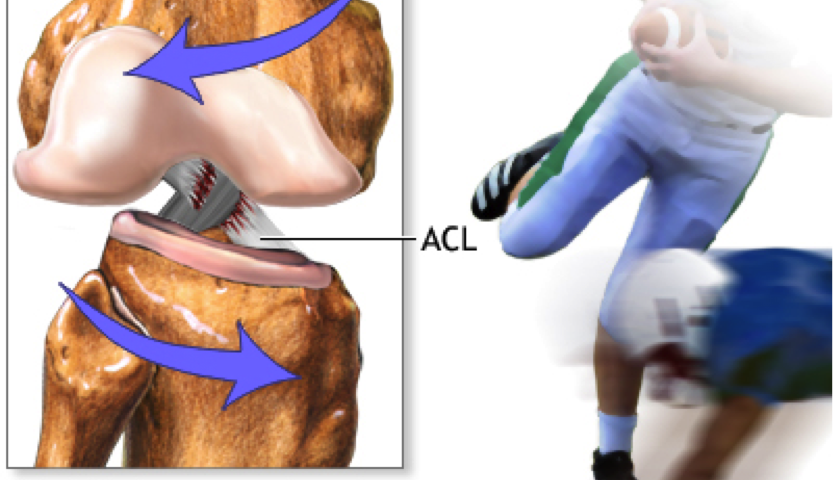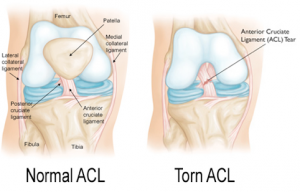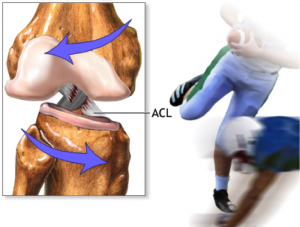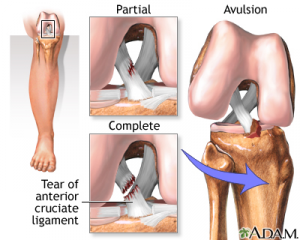Your Journey to ACL recovery

PLANTAR FASCIITIS / HEEL PAIN
July 27, 2016
What is True core stability ?
September 18, 2016The knee has four main ligaments that provide joint stability and guide knee movements in proper direction. Those four ligaments include:
-Anterior cruciate ligament (ACL): prevents lower leg from slipping forward in front of the thigh bone (femur) and controls medial rotation of the lower leg
-Posterior Cruciate Ligament (PCL): prevents lower leg from slipping backwards under the thigh bone
-Medial collateral ligament (MCL): prevents the knee from shifting inwards
-Lateral Collateral ligament (LCL): prevents the knee from shifting outwards
The importance of ACL
The ACL is one of the most important stabilizers of the knee along with the knee muscles (quadriceps, hamstrings… Etc.). It stabilizes the knee in flexion preventing the lower leg from slipping forward as well as stabilizing the knee joint in rotational movements. It is made of collagen fibers intertwined together allowing it to withstand up to 500lbs of force.
ACL injury can be caused by:
- Rapidly changing directions
- Stopping abruptly
- Landing incorrectly from a jump
- Twisting while foot is firmly fixed on the floor
- Receiving a direct blow to the knee
- Falls such as from stairs
ACL injuries are common in sports such as football, basketball, skiing, and gymnastics…etc. Approximately 50% of ACL injuries involve damage to other structures such as meniscus and collateral ligaments and/or bone bruises.
Research has shown that females are at higher risk for ACL injuries due to several reasons such as weakness or inactivation of hamstrings, discrepancy in muscle strength, laxity of ligaments due to hormonal effects, greater Q angle (due to wider pelvis) which puts more stress on the ACL during twisting motions.
Symptoms of ACL injury:
- Pain in or behind the knee; especially with knee movements or while walking
- Knee swelling
- Popping sensation may be felt at the time of injury
- Limited range of knee motion; inability to fully bend or straighten knee.
- Instability or buckling of knee when walking. Knee “gives way”
- Failure to resume activity
The ACL can be either strained/overstretched or torn depending on the severity:
Grade 1: Ligament is overstretched but is still intact. Knee joint is stable.
Grade 2: Ligament is partially torn. Knee may give out or feel unstable
Grade 3: Complete ligament tear. Knee is unstable.
Most ACL injuries are complete tears and rarely partial tears. Moreover, ACL can be torn in half or ripped off from the bone. ACL injuries rarely heal on their own due to their poor vascularity; they don’t have enough blood supply.
Diagnosis
ACL injuries can be diagnosed through history taking and physical examination where a doctor performs series of tests and moves the knee through various positions to identify any damage or loss of function in the knee.
MRI can be used to detect damage to soft tissues such as ACL and other structures within the knee, thereby confirming the diagnosis.
Treatment
Treatment of ACL injury will depend on the severity of the injury as well as the patient’s level of activity.
Non-surgical treatment is recommended in the following cases:
- Grade 1 ACL sprain where only the ACL is affected
- Older inactive patients
- Participation in low intensity sports or exercises that don’t exert a lot of stress on the knee
Progressive physiotherapy has shown to be successful in recovery of grade 1 ACL injuries and help prevent knee instability and recurrent injuries
The goal of ACL rehabilitation will include the following:
- Reduce pain using ice, manual therapy, electrical stimulation, dry needling, taping…etc.
- Restore normal range of motion of knee
- Increase in muscle strength through various exercises (isometric, resistive training of hamstrings and quadriceps to compensate for weak ligaments)
- Improve knee stability by balance and proprioceptive exercises and functional training
 Surgical treatment is usually recommended for:
Surgical treatment is usually recommended for:
- Grade 2 or grade 3 ACL sprains
- Combined injuries (ACL tear with injury to other structures such as meniscus or collateral ligament)
- Young active patients who wish to continue performing sports
Surgery to repair the ACL is usually performed few weeks after injury until the swelling and inflammation resolves, allowing the knee to return to normal range of motion. Otherwise early surgery can increase the risk of scar formation (arthrofibrosis) within the joint, which would restrict knee movements.
Surgical repair of the ACL by stitching the ligament together has shown to be less effective as it can result in recurrent instability. Instead surgery will involve reconstruction of the ligament whereby the torn ligament is replaced by a tissue graft taken from another source. Grafts to replace the ACL ligament can be obtained from the following sources:
- Patellar tendon
- Hamstrings tendon (most common)
- Quadriceps tendon
- Allograft, which is taken from a cadaver (can be from Achilles tendon, patellar tendon …etc.)
Surgical repair is usually done through an arthroscope where a small incision is made in front of the knee and the graft is then inserted and placed in the same position as the ACL. Arthroscopic surgeries have the advantage of causing less pain, smaller scars, shorter stay in hospital and faster recovery as opposed to more invasive techniques.
ACL treated by surgical reconstruction have shown success rates of 82 percent to 95 percent and recurrent instability is seen in about 8 percent of patients. Surgical reconstruction of the ACL aims to restore the function of the knee and prevent instability thereby allowing the patient to return to performing sports.
I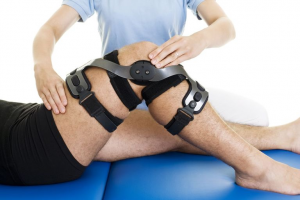 mportance of rehab after ACL surgery
mportance of rehab after ACL surgery
Rehabilitation after ACL surgery is very important for recovery and returning to normal daily activities or sports. After ACL surgery the patient will use a brace around the knee as well as crutches during the first few weeks to protect the knee and the new ligament. Physiotherapy and rehabilitation is started as early as first week after surgery. A comprehensive rehabilitation program will include the following:
- Week 1: reduce pain and swelling, early range of motion exercises
- Week 2-4:improve patellar mobility, regain full range of motion and knee extension
- Week 4-8: strengthening and stability exercises for the knee
- Week 8-12: functional tr aining and sports-specific exercises
- After 6 months: gradual return to sports with mild intensity
- After 8-12 months: return to sports
Recovery after ACL surgery usually takes 6-12 months depending on the sports and provided that physiotherapy and a rehabilitation program are implemented. Returning to sports is only permitted when there is no longer any knee pain, knee range of motion, strength and stability, neuromuscular control and functional movement of the knee are restored.
Nermine.

